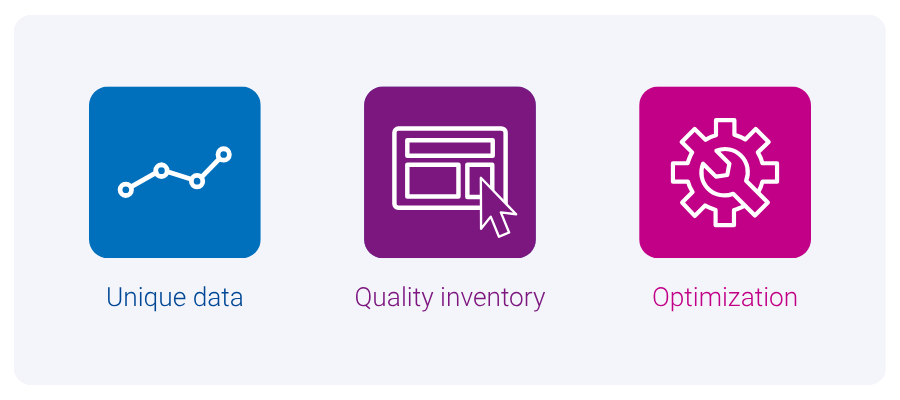At A Glance
Curation is changing how media is bought and sold, moving beyond open auctions and static site lists to more efficient deals. By combining unique data, real-time supply connections, and continuous optimization, curated PMPs reduce waste and improve results. Audigent's, a part of Experian, solutions help marketers achieve measurable outcomes with curated strategies that deliver better targeting, higher engagement, and improved ROI.If you buy media today, you’re already feeling the shift: the best results don’t always come from broad, open auctions or static “safe site” lists; they’re coming from deals that combine the right data with the right inventory and let algorithms optimize in real time. That’s curation. And when it’s done right, it reduces data and media waste for buyers and raises eCPMs (effective cost per thousand impressions) and win rates for publishers.

As part of our Cannes Content Studio series, leaders from Butler/Till, Index Exchange, OpenX, PubMatic, and Yieldmo discuss how curation cuts waste and lifts results.
What is real curation?
Real curation isn’t “packaging inventory.” It’s a strategic framework built on three pillars:
Why it matters: Manual approaches hit a ceiling. They can’t react quickly to shifting content, identity signals, or auction dynamics. That’s where technology partners come in, keeping the optimization loop running continuously.
Intelligence at every touchpoint
Curation isn’t about shifting control between platforms. It’s about better brand decisions, connecting opportunity-rich supply to the brand’s preferred buying platform and enriching each buy with audience data.In practice, supply-side platforms (SSPs) are ingesting richer signals to route inventory more effectively and support frequency caps and deal prioritization, in collaboration with demand-side platforms (DSPs).
“I think we’re seeing a shift toward bringing more DSP capabilities into the SSP, like supply-side targeting and data driven curation. Advancements in areas like CTV are enabling targeting based on content signals, and SSPs are pulling in more data to inform which supply is sent to the DSP, helping with things like frequency caps.”
OpenXMatt Sattel
Why page-level targeting beats static lists
Static domain lists were a useful first step for quality control. The intent was sound, but the approach was too cumbersome for today’s signal-rich buying. Today, AI and contextual engines read the page, not just the site, and adapt in real time.

Page-level logic delivers three key benefits:
- Accuracy by targeting high-intent, page-level content.
- Relevance by matching the creative to both the content and the audience context.
- Speed by enabling campaigns to move away from underperforming pages in real time, without waiting for a manual trafficking change.
“AI-driven contextual engines evaluate the page, not just the domain, to curate inventory in real time. That moves curation from static allowlists to adaptive logic for greater accuracy, relevance, and speed.”
YieldmoSophia Su
Partnerships broaden who influences the buy

Curation works when publishers, agencies, data partners, and platforms share signals and KPIs.
- Horizontal curation (across multiple SSPs) assembles broader, higher-quality reach and resilience, ideal for scale and diversity of supply.
- Vertical curation (an SSP’s in-house product) provides deep controls within a single exchange, useful for specific inventory strategies.
- Creative and data now shape supply and demand: better creative decisioning, tested against richer signals, improves outcomes.
DSPs remain central for activation and pacing. But the sell-side’s growing intelligence means more accurate inventory routing and signal application before a bid ever fires.
“Curation will continue to evolve through deeper data partnerships and expanded use across publishers and agencies, with more sophisticated types of optimization. DSPs will remain critical to activation, even as sell-side decisioning plays a larger role in identifying and shaping the supply to select.”
Index ExchangeMike McNeeley
Curation delivers access and measurable performance

Here’s what curated deals are delivering.
For buyers
| Result | Type of result |
| 36-81% | savings on data segments |
| 10-70% | lower cost per click (CPCs) |
| 1.5-3x | higher click-through rates (CTRs) |
| 10-30% | higher video completion rates |
For publishers
| Result | Type of result |
| 20% | bid density |
| 118% | win rate |
| 10% | revenue on discovered inventory |
| 25% | eCRM on incremental impressions |
Why it works: When data, supply, and optimization are integrated, you reduce waste, surface better impressions, and let algorithms compound your advantage. That’s why curated private marketplaces (PMPs) have grown at ~19% compound annual growth rate (CAGR) since 2019.
“Publishers using supply-side curation see ~15% more diverse buyers and 20–25% better performance than buy-side-only targeting. Smarter packaging and signal application tighten auctions and strengthen outcomes.”
PubmaticHoward Luks
Holistic curation streamlines planning and outcomes

Curation adds the data layer earlier in the buying process, starting at the supply-side. This creates more opportunities to reach the right audience and improves scale and performance. By replacing multiple line items with a single curated deal, campaign setup becomes faster and less error-prone. Curated deals also simplify measurement by including the necessary context for accurate attribution, while dynamic adjustments ensure campaigns remain optimized without requiring manual updates.
“Publishers using supply-side curation see ~15% more diverse buyers and 20–25% better performance than buy-side-only targeting. Smarter packaging and signal application tighten auctions and strengthen outcomes.”
Butler/TillGina Whelehan
It’s much more streamlined, bringing more pieces together so we’re thoughtful and holistic. Adding the audience and data element creates more scale and strategy in how we curate supply and data, and ultimately better results for clients.
The bottom line
Curation has matured from buzzword to performance system. DSPs still anchor activation and pacing, but better sell-side pipes now pre-route inventory and apply signals before any bid starts, making the whole system faster and more accurate. When you combine unique signals, tight supply connections, and always-on optimization, you gain addressability, reduce waste, and achieve better business outcomes for both buyers and sellers.
Curation isn’t just a trend; it’s where programmatic advertising is headed. Start testing curated PMPs today to see the difference for yourself.
Explore curated PMPs with Audigent
Curation FAQs
Curation in performance marketing is the process of combining data, inventory, and optimization to deliver better results. Audigent supports curated strategies through privacy-safe data and advanced integrations.
Curation reduces wasted spend by targeting high-quality impressions and optimizing campaigns in real time. Audigent’s solutions help marketers achieve higher click-through rates, lower costs, and better engagement across channels.
Curated PMPs are deals that use curated data and inventory to deliver measurable results. They help buyers save on data costs, improve ad performance, and achieve better video completion rates, while publishers see higher win rates and revenue.
Audigent provides unique data assets, privacy-safe integrations, and optimization tools that help marketers and publishers create curated deals. Our solutions ensure campaigns are more efficient, targeted, and effective from start to finish.
Horizontal curation combines inventory across multiple platforms for broader reach and diversity, while vertical curation focuses on deep control within a single platform. Both approaches can be tailored to specific campaign goals with Audigent’s expertise.
Latest posts

It seems that every time I go into a store today, I am offered a loyalty card. From one of my favorite local restaurants to my shoe store VIP program, I feel like I am getting a host of emails and points at every turn. Statistics support my theory: according to a recent Experian Data Quality study, 91 percent of organizations use loyalty programs. Why did they become so prevalent? Today’s consumer is more empowered than ever before and driving major change within business. In the era of Yelp, digital channels and a 24/7 shopping cycle, organizations have less control. Just look at the shoe market, which you can tell I pay attention to. It used to be that you would purchase whatever your local department store or brick-and-mortar retail had to offer, which might be 50 different options. Now, you can go online, read reviews and browse hundreds of different choices based on style and color. In fact, last night I went online and searched for black boots and scrolled through six pages of different options! Loyalty programs are a counter balance to that choice and empowered customer behavior. They make sure that while I am shopping for shoes, I am probably doing it through my preferred store and earning reward points for free merchandise. And through the loyalty process, companies are collecting a lot of data. Customers usually need to provide more than three types of information to sign up, the most popular being email, followed by name and phone number. However, collecting this information accurately isn’t always easy, which is why poor data collection is one of the leading problems for loyalty programs. Eighty-one percent of companies face challenges related to these programs, the two biggest being not enough customers signing up and poor contact data. Inaccurate data means that a customer has signed up, but the marketer is unable to communicate with them in the desired channels. This clear drop in communication and a potentially bad customer experience could be by improved data collection. Sixty-four percent of respondents say this is a needed improvement. Let’s go back to my shoe retailer example. If they had collected my email wrong, I wouldn’t get my email confirmations or offers around upcoming sales. If they got my address wrong, I wouldn’t be receiving my shoes. Considering how much money I spend on shoes annually, which I am ashamed to admit, if any of those items went wrong, I might switch to a competitor. That can equate to a lot of money annually, especially when you look at it across a large number of clients. When a customer chooses to sign up for a loyalty program, they are making a commitment to the company and expecting something in return, be it points, free shipping, coupons or just company updates. However, if bad contact information is collected, then the consumer often never receives the benefits, resulting in a bad customer experience. In the next year, marketers need to data validation in place to ensure information is accurate upon collection. This type of software can be implemented across all channels where information is collected and ensure data is accurate while the consumer is still engaged. If information is accurate when it is collected, then loyalty programs have a better chance at engaging consumers and actually seeing the benefit that a loyalty program can provide. To learn more about loyalty programs and the research mentioned above, please read our new white paper, Driving customer loyalty. Contact us today

Black Friday online traffic increased 7% in 2012 versus 2011 as the top 500 retail sites received more than 193.8 million total US visits. So far this Holiday week of online traffic to the top retail sites is up 10% on average. Online retail traffic was up 1% on Black Friday compared to Thanksgiving Day 2012 traffic this year. Amazon.com remained the top visited retail site on Black Friday while Walmart was the second most visited retail site. BestBuy moved up to the 3rd most visited site while Target was the 4th most visited site. JC Penney moved up from being the 8th most visited retail site on Thanksgiving Day to the 5th most visited on Black Friday. Among the top 5 sites, JC Penney saw the biggest day-over-day growth at 26%. Looking at the top 20 retail sites on Black Friday, the Apple Store site saw the biggest day-over-day growth at 99%. Check back for CyberMonday insight and a weekly recap of this week. Contact us today

It is time for us to polish off our crystal ball and give our predictions straight from consumers’ fingertips for the hot products of the 2012 holiday season. Gadgets will reign across many ages Tablets including LeapPads, Tabeos, iPads, Kindles and others will continue to be a popular gift this year, with more choices than ever. On the list of top product-related search terms driving traffic to the Retail 500 category of sites, Kindle Fire HD and Windows 8 top the list as new products. Additionally, Meep!, a child friendly tablet appeared in the top fifteen. Accessories for both phones and tablets will also be popular, especially as the variety grows for iPhone 5 and iPad Mini. A reoccurring favorite gift for the holidays is UGGs which shows a decrease year over year. However, another brand with a similar product is Bearpaw, which is in the top ten searches and has seen big growth year over year.Source: Experian Hitwise Dolls, video games and Furbys, oh my! To identify the popular toys for gifts this year, we researched product-related search terms driving traffic to ToysRUs.com compared to last year’s holiday season. We uncovered trends in the doll category, Doc McStuffins as number one on the list, along with the classic Barbie, which saw a growth in searches year over year. The Furby is making a strong comeback at the number two spot with a reboot and new features. Another trend here is tablets, from branded searches like LeapPad and Kurio there is also the generic term ‘tablets for kids’. In the video game category, the new Wii U that is debuting just in time for Black Friday and should be a big gift this year, along with searches for PS3 games and the Nintendo 3ds xl are all in the top 20 searches.Source: Experian Hitwise Keywords of the consumer to identify demand Beyond product names, it is important to understand the actual way people search, using key phrases and questions. Last year, for example, there was a lot of activity around ‘in-stock’ products, such as the LeapPad explorer, which was hugely popular and quickly sold out in many stores. Retailers and marketers should monitor this throughout the season and make sure to optimize for in stock if there is a popular product that they have available.Source: Experian Hitwise Consumers also focus on what is the ‘best’ – so we see search activity around ‘best place to buy’, particularly around electronics. Questions such as ‘where to buy a’ specific product are also common, such as ‘where to buy a kindle’. These phrases offer opportunities to boost search campaigns by considering how consumers phrase their questions to ensure to capture these searches.Source: Experian Hitwise Quick tip: In the retail category there will tend to be a lot of retail branded store terms but to keep up with holiday search behavior and help make analysis quick, create portfolios of branded terms to easily exclude those from a certain category. When you strip out all the variations of that term you are able to gain insight into product searches that are most popular to a certain site or category. For more insight on the hot product trends for this year from our Hitwise trend-spotters, watch our webcast. Contact us today


